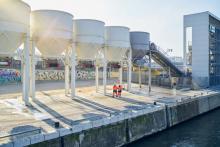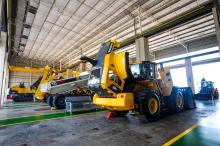French aggregates demand is finally picking up after a number of tough years for quarry operators and contractors. Guy Woodford reports.
French aggregates demand has been falling in recent years. Production estimates from the
Despite declining demand, France remains Europe’s fourth biggest annual aggregates producer – behind Germany (545 million tonnes in 2015), Russia (509 million tonnes) and Turkey (500 million tonnes), respectively.
In its Q2 2017 performance report
Other more recent figures also show a far more promising picture for the country’s 1600 plus aggregate producers, as Grégoire Daviron, sales & services director for
“Aggregates demand in France seems to have restarted – up 4.4% in the past year. Even if we are far from the ‘good old times’, at least direction is better, and we can expect a 2% rise in demand this year (compared to the full year 2016). Demand for concrete is restarting faster than aggregates, pushed mainly by the construction building industry.”
Daviron says new major French infrastructure projects including the Seine–Nord Europe Canal - a projected high-capacity canal linking Oise River at Compiègne with the Canal Dunkerque-Escaut, east of Arleux – have been put on hold by the country’s new president, Emmanuel Macron. Macron came to power in May this year pledging to tackle the national debt while, at the same time, transforming France’s complex labour laws aimed at tackling mass unemployment, which, he argues, will make the country more competitive in the global market.
Daviron continues: “President Macron has announced a main focus on ‘daily use infrastructures’ with a budget of €50 billion for the next five years. More details will be announced later, but it clearly excludes a new high speed train line, new highways, or such high aggregates consuming projects. Priority will be also given to house building, particularly social housing and low costs housing for students.”
Despite presidential focus moving away from major infrastructure projects, the Grand Paris project is one megaproject continuing to have a significant regional impact on aggregates production. The project includes hundreds of new kilometres of métro lines to improve transport links between Paris suburbs, with some aggregate industry experts putting the annual aggregates need of the project at 10 million tonnes.
Looking at French aggregates market trends, Daviron says that there is “definitely” a growing interest among French customers in low, or negative, capital solutions. “Metso is well-positioned with its large land coverage and comprehensive service capabilities to offer solutions well-adapted to customers’ requirements. This includes service contracts, rental and financing solutions.
“Consideration of environment protection and operators’ safety is also a growing criteria for all our customers, and legislation includes more and more requirements in this area. Metso’s large experience of turnkey plants and portfolio of solutions gives us the possibility to adapt our offering on a tailor-made basis to help our customers to fulfil their commitments.”
A recent web blog from the organisers of
The nationwide market significantly fuelled the growth in sales of French construction equipment by CISMA members, rising by 42.5% to stand at €1.12 billion. Such figures will also be welcomed by France’s aggregates producers, ready to meet any growing national construction sector need for raw building materials.
“The over-depreciation law had a genuine effect on the equipment market,” notes Renaud Buronfosse, CISMA’s managing director, in the pre-INTERMAT blog. “This was particularly evident in the first four months of the year. Rental firms made investments, which they hadn’t done for a long time, and constructors also invested to replace ageing equipment fleets. I should also add that building is doing better since October 2015 and that the public works environment has picked up since September-October 2016. We could therefore conclude that the economic climate should take up where the ‘Macron Act’ left off.”
Buronfosse estimates that the French construction equipment market will grow by 10% in 2017. Jean-Claude Fayat, CISMA’s chairman, shares this view, but, while noting the upturn in buildings, remains prudent in the area of public works, pointing to “a certain fragility in the recovery”, and “a persistent lack of visibility”. The CISMA chairman advocates the extension of the over-depreciation law which he sees as “a genuine support to investment”.
“Considering the good health of the domestic market, French manufacturers have delivered to their domestic clients first,” believes Buronfosse, explaining the drop in foreign sales which amounted to €1.81 billion in 2016 (-5.7%). “Our sector still remains one of the few in the mechanical sector which display a positive trade balance, with an export ratio (exports/national production) of 62% and an export-to-import ratio of 102%,” the CISMA MD concludes.
The pre-INTERMAT blog notes that the European Union is the largest customer of French industry (45% of sales). The second on the list, North America, accounts for 18.2% of exports. But while Europe did better than keep its rank in CISMA’s figures (+2%), North America dropped severely (-19%), as did third-placed region Africa (11.4% of exports), to which sales fell by 21%.
Germany continues to be the leading importer of French equipment and machinery (15.5%), ahead of the USA (14.3%). The sales to the former substantially increased in 2016 (+13%) whereas they fell heavily towards the latter (-28%). All the other European countries that buy French machinery showed a decline. “French manufacturers capitalised on the strong German market in 2016, but in the UK, the drop in sterling made imports more expensive and this probably benefited British manufacturers in their own market. The view of French manufacturers towards the United States is not out of step with the market of last year,” adds Buronfosse.
The CISMA MD considers that the construction activities of CISMA members in 2017, domestic market and exports combined, could rise by 5-6%.
Christiane Camus-Pardon, Volvo Construction Equipment France’s director of communications & marketing, is another senior figure in the French operation of a leading global OEM who sees shoots of recovery in French construction equipment demand.
“After several flat years and 2017’s slow start due to bad weather conditions, it seems that all signs have now turned to green. The French public works association forecast is +1% in 2017 and + 2% in 2018. All product lines in which we compete have improved vs 2016 except wheeled loaders.
“Our key account customers are more and more looking into a complete offer (including equipment servicing). We also see some interest for ‘Rebuild’ machines as an alternative to new investment.
“Last year,
Camus-Pardon notes how the French government’s environment agenda is also influencing Volvo CE customer operations. “Standards are more and more demanding when it comes to environmental care. Our customers are following this demand very keenly. Our key account holders are also very aware of their employees’ safety. This led Volvo to develop a three-point in-cab safety belt for their machines. The key account holders also organise safety forums and training for their staff.”









